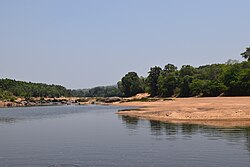| Tunga River | |
|---|---|
 River Tunga near Chibbalagudde, Thirthahalli | |
 | |
| Location | |
| Country | India |
| State | Karnataka |
| Physical characteristics | |
| Source | Gangamoola |
| • location | Chikmagalur district, Karnataka, India |
| Mouth | Tungabhadra River |
• location | Koodli, Bhadravati, Karnataka, India |
| Length | 147 km (91 mi)approx. |
The Tunga River (alternatively spelled Thunga) is a river in Karnataka state, southern India. The river is born in the Western Ghats (Sahyadri mountains) on a hill known as Varaha Parvata at a place called Gangamoola in Chikkamagaluru district. [1] From here, the river flows through two districts in Karnataka - Chikmagalur District and Shimoga District. [2]
Contents
It is 147 km long and merges with the Bhadra River at Koodli, a small town near Shimoga City, Karnataka. [2] The confluence of the two rivers continues as Tungabhadra from this point on. The Tungabhadra flows eastwards and merges with the Krishna River in Andhra Pradesh.
It has a dam built across it at Gajanur, and a larger dam has been built across the compound Tungabhadra river at Hospet.